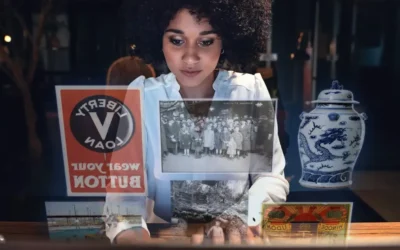Museum Digital Projects: Pre-Project Evaluation

Rachael Cristine Woody
As a follow up to the “Ask Me Anything: Museum Digital Projects” webinar, this series of posts will review the questions we received in order to provide additional insight, strategies, and resources.
Additionally, we received several excellent questions after the deadline and have decided to include them in this series. Our thanks to everyone who sent in questions! Your participation helps us to craft future content that is of the most use to you, our colleagues.
Today’s Post
Today’s post will focus on pre-project evaluation as an exercise to help inform the construction of your next digital project.
Q. Did you do any evaluations ahead of time to determine what content to include in the project?
And a related, but more specific question: Q. We have items cataloged in a CMS, but we have hardly any digital surrogates. What recommendations do you have for choosing where to begin?
I highly recommend periodic evaluations of museum digital project needs, as well as evaluations performed in order to inform an impending digital project. There are two areas I recommend reviewing in order to inform upcoming digital project work: quality of existing content online; and collection content online vs collection holdings. A museum with an even representation of the collection within the collections management system is rare. Changing priorities, staff transition, unstable funding, and exhibits of any given year can lead to imbalanced creation of the museum digital collection. This is a common scenario and one that museum staff should strive to rectify in order to create a more accurate and representative account of the museum collections online.
Evaluation of a Museum Collection’s Digital Presence
If the museum doesn’t already have a system of evaluation in place, the following prompts for evaluation should be considered:
1. Is the quality of the digital files acceptable?
Digital capture that took place 5, 10, 15 or more years ago will not hold up nearly as well in terms of quality and should be considered for a re-shoot. It’s important for digital files to be of high-quality since optimum quality files will encourage more digital user interaction, and will provide the best possible files for future digital migration and preservation.
2. Is the cataloging information correct and does it meet industry standards?
Catalog records of collection objects should be compared with the museum’s established standards. Catalog records that fail to meet the minimum requirements should be updated.
3. Are there areas of the catalog record that are optional, but could be used to improve access and enjoyment of the object?
While a catalog record can meet museum requirements, it may be improved upon with the use of additional descriptive fields. Adding additional descriptive information to promote access and enjoyment of a museum object should be considered as time and resources allow.
4. Which objects are completely hidden?
For many museums there is still so much of the collections that are “hidden”—meaning the object is in storage and not on exhibit and/or doesn’t have an easily discoverable place online. If there are collection areas that are not on display in any capacity, they should be prioritized higher for museum digitization projects and cataloging in the museum collections management system (CMS).
5. Which objects are in danger of disappearing?
Many museum collections have objects that are in danger of disappearing. Preservation issues inherent to the object based on how it was made, the materials it’s composed of, and the conditions it’s been physically subjected to all contribute to the object’s eventual expiration date.
6. Which objects are most frequently used?
Creating a digital surrogate and making it available through the museum collections management system will help alleviate the wear and tear on the object, and will help meet the demand from audience members who can work with a digital surrogate of the object.
7. Which objects can provide better representation?
In order to meet Diversity, Equity, and Inclusion measures, museums are reviewing and evolving all areas of work. Areas of the collection that may help present a more informed, accurate, and authentic account of historical events, places, and people need to be prioritized.
8. Which objects can support current projects or museum efforts?
If there’s a new exhibit planned, a community event, or other work the museum will be engaged in that could be buoyed by digital availability of the objects involved, that work should be anticipated and prioritized.
Additional Reading
For more digital project ideas please see How to Identify Museum Digital Project Ideas, How to Choose Your Next Digital Project Idea, and The Most Common Museum Digital Project Types available via Lucidea’s Think Clearly Blog.
Conclusion
As you build the museum digital program and online collection offerings, you’ll gain a better sense of where you have current strengths and gaps. You may also find that some prompts are more helpful for you to focus on than others, and you’ll likely develop a few of your own! Regardless of the prompts you use, pre-project evaluation is an excellent approach to intentional work—setting you and the museum collections up for a more successful result.

Rachael Cristine Woody
Consultant, author, and blogger Rachael Cristine Woody advises on museum strategies, collections management and grant writing for a wide variety of clients. Learn about Lucidea’s Argus solution for museum collections management and digitization and read more of Rachael’s blog posts here.
Never miss another post. Subscribe today!
Similar Posts
How Archives Can Enrich Museum Collections Online
Staffed archives are in constant motion in their attempt to provide and broaden access to the archival collections.
How to Enhance Museum Collections Online with New Information
One of the wonderful things about museums is that the learning never stops. There are always projects, exhibits, and programs in development that serve as constant instigators of research.
How to Enhance the Museum Object Record with Immediately Available Information
This month’s series focuses on the enhancement of museum object data using “hidden” troves of information. Hidden is in quotes because the information exists and often is not hidden—it just hasn’t been gathered for inclusion in the museum Collections Management System (CMS).
Where the Gaps Live with Traditional Museum Object Cataloging
Standard museum cataloging leverages the usual set of fields that are considered best practice. We tend to refer to this information as “the tombstone information,” meaning it is clear and concise in communicating the “need to know” information.




Leave a Comment
Comments are reviewed and must adhere to our comments policy.
0 Comments